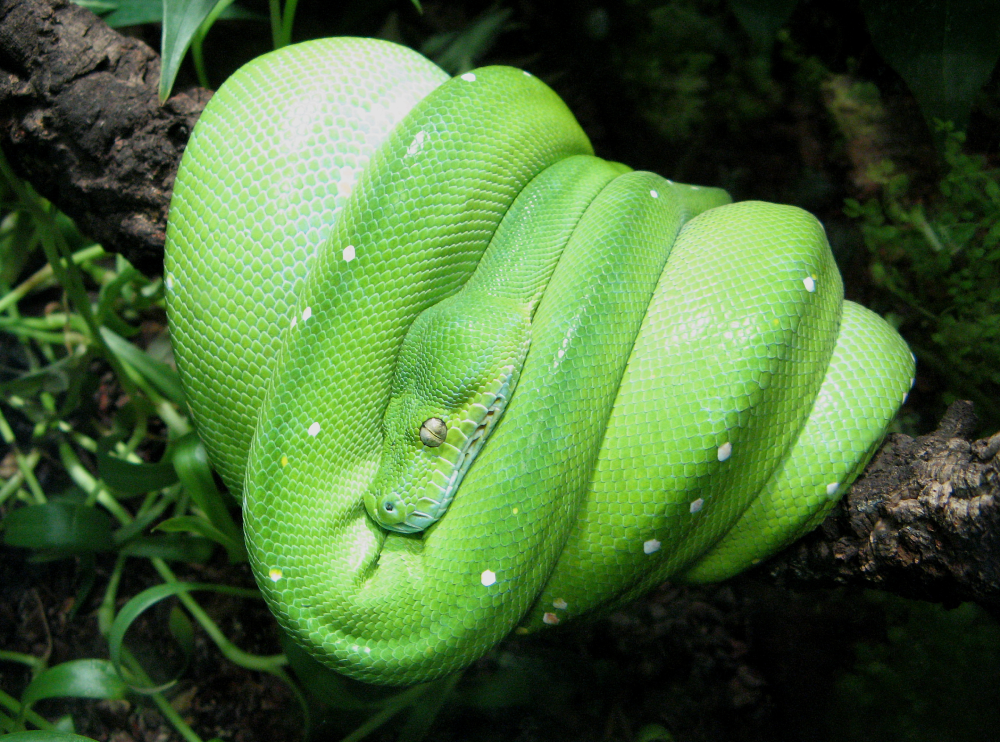In the dense rainforests of New Guinea, Australia, and the surrounding islands, a creature of remarkable beauty slithers gracefully through the treetops. The Green Tree Python (Morelia viridis) is not only a master of camouflage but also an icon of the reptile world, captivating enthusiasts and researchers alike with its vibrant coloration and enigmatic behavior. In this article, we delve into the intricate world of the Green Tree Python, exploring its physiology, behavior, ecological significance, and its unique place in human culture.
Physiology and Appearance
The Green Tree Python is a non-venomous constrictor belonging to the family Pythonidae. As its name suggests, it spends much of its life high in the trees, where its vivid green scales serve as impeccable camouflage among the foliage. However, it’s worth noting that while the green coloration is the most common, individuals can also exhibit shades of blue, yellow, or even black.
One of the most striking features of the Green Tree Python is its prehensile tail, which is perfect for gripping branches with remarkable strength and agility. This adaptation allows the snake to maneuver through the treetops with ease, making it a highly efficient arboreal predator.

Behavior and Reproduction
Despite its intimidating appearance, the Green Tree Python is generally docile in temperament, often preferring to remain motionless for hours at a time while waiting for prey to pass by. It primarily feeds on small mammals, birds, and occasionally reptiles, using its powerful constricting muscles to subdue its prey before swallowing it whole.
Breeding in Green Tree Pythons is a complex process that involves intricate courtship rituals and elaborate displays of behavior. Males will often engage in combat with rival suitors, entwining their bodies in a show of strength and dominance. Once a mating pair has been established, the female will lay a clutch of eggs, which she will then incubate by coiling around them and generating heat through muscular contractions.
Ecological Significance
As apex predators in their native habitats, Green Tree Pythons play a crucial role in regulating populations of prey species, helping to maintain the delicate balance of the ecosystem. Their presence also serves as an indicator of the overall health of the environment, as they are highly sensitive to changes in temperature, humidity, and habitat destruction.
Conservation Status and Threats
Despite their importance in the ecosystem, Green Tree Pythons face numerous threats to their survival, primarily as a result of habitat loss, poaching, and the illegal pet trade. Deforestation, in particular, poses a significant risk to their populations, as it deprives them of their natural habitat and disrupts their breeding cycles.
Efforts to conserve Green Tree Pythons are underway, with organizations and researchers working to raise awareness about the importance of protecting their habitats and combating illegal trafficking. Captive breeding programs have also been established to reduce the demand for wild-caught individuals and ensure the long-term viability of the species.
Cultural Significance
Beyond their ecological importance, Green Tree Pythons hold a special place in the hearts and minds of people around the world, inspiring awe and fascination with their otherworldly beauty and mysterious behavior. In indigenous cultures, they are symbols of wisdom, fertility, and the cycle of life and death.
In modern times, Green Tree Pythons have become popular subjects in art, literature, and popular culture, appearing in everything from ancient cave paintings to contemporary films and video games. Their striking appearance and elusive nature continue to captivate the imaginations of people of all ages, ensuring their place as one of nature’s most iconic creatures.
Conclusion
In the vast and diverse tapestry of the natural world, few creatures command attention quite like the Green Tree Python. With its vibrant coloration, graceful movements, and enigmatic behavior, it serves as a reminder of the beauty and wonder that can be found in even the most remote corners of the Earth. So, as we strive to protect and preserve our planet’s biodiversity, let us not forget the invaluable role that creatures like the Green Tree Python play in maintaining the rich tapestry of life on our planet.









